Drafty windows can silently harm your houseplants by creating sudden temperature fluctuations that disrupt their growth. You'll notice subtle signs like yellowing leaves, unexpected wilting, and plants leaning away from windows as they try to escape cold air. Most houseplants need stable temperatures between 60-75°F to thrive, and cold drafts can shock their metabolic processes. Understanding these warning signals and implementing protective measures will help your indoor garden flourish all winter long.
Signs Your Plants Are Suffering From Cold Drafts
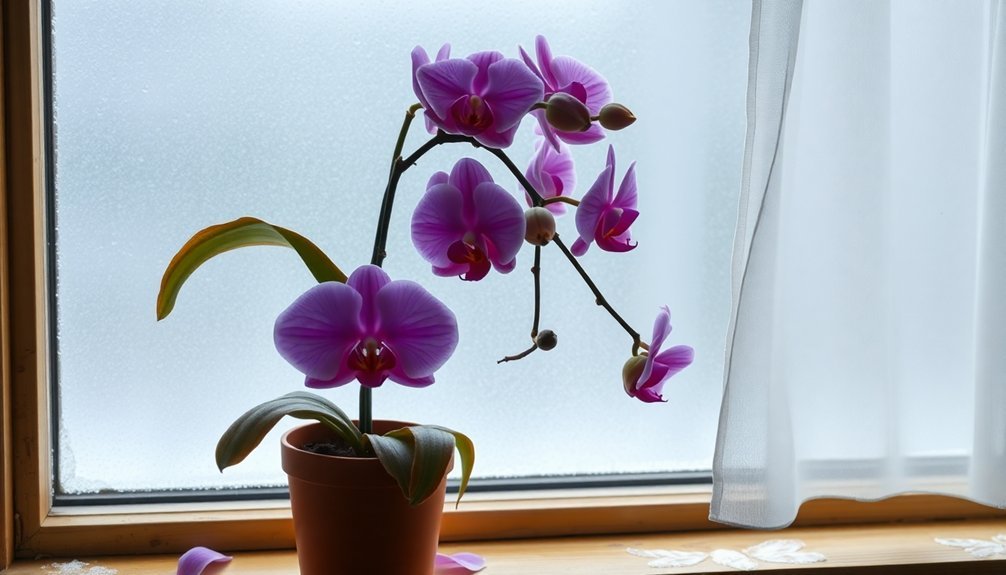
How can you tell if your houseplants are battling against chilly window drafts? Your plants will send clear distress signals long before plant death occurs.
Watch for yellowing leaves and sudden wilting, even when the soil's moisture level is appropriate. If you notice leaves dropping unexpectedly or curling at the edges with brown spots, cold drafts may be the culprit.
Yellowing, wilting leaves and brown-edged curling foliage are telltale signs your plants are suffering from cold window drafts.
Pay attention to your plant's growth pattern. If it's stretching or leaning away from the window, it's likely trying to escape cold air.
These symptoms often appear when temperatures fluctuate beyond the ideal 60-75°F range. When multiple signs occur simultaneously, it's essential to act quickly by moving your plants to a draft-free location where they can maintain stable temperatures and recover their health.
Common Window Draft Problems Affecting Plants
While homeowners often focus on energy costs, drafty windows pose several distinct challenges for indoor plants. Since many houseplants are tropical plants that thrive in consistent temperatures, these drafts can greatly impact their health.
Common window draft issues you'll need to address include:
- Temperature fluctuations that shock sensitive plants, disrupting their natural growth patterns.
- Cold air leaks around window frames that create hostile microclimates for your plants.
- Uneven temperature distribution that forces plants to constantly adjust their metabolic processes.
- Hidden air gaps that create subtle but persistent cold zones.
To protect your plants, regularly check for drafts by running your hand along window edges and corners. If you detect cold spots, consider caulking the windows or relocating your plants to more stable areas within your home.
The Science Behind Plant Stress and Air Movement
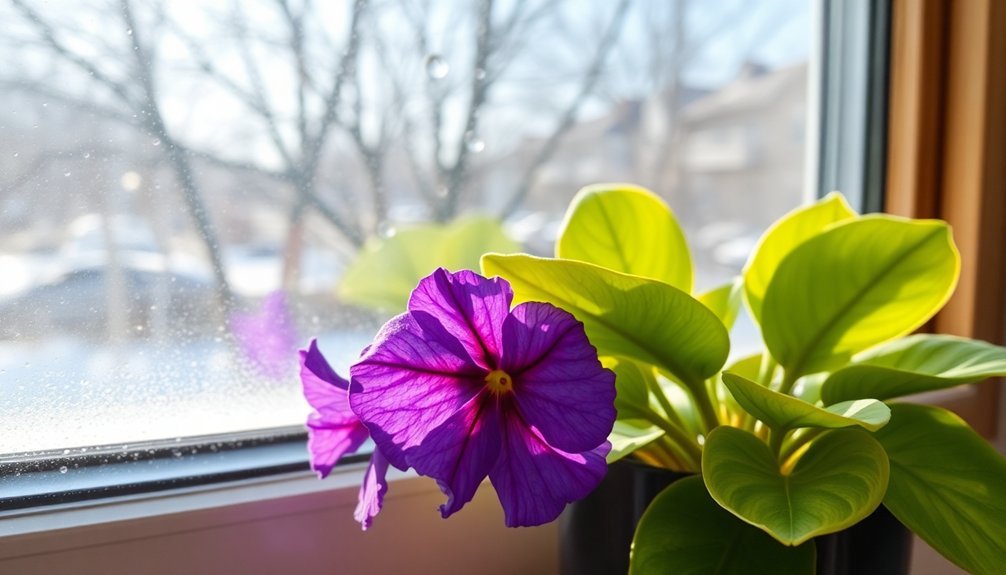
Understanding the science of plant stress reveals why drafts pose such a serious threat to your houseplants' survival. When cold air moves across your plants, it disrupts their essential biological processes, including photosynthesis and nutrient absorption. This interference can quickly lead to visible signs of distress in your plant care routine.
The most concerning impact comes from increased transpiration rates. As drafts create air movement, your plants lose water faster than they can replenish it, leading to dehydration. The dry air near drafty windows compounds this problem.
Additionally, your plants' roots struggle to maintain consistent moisture uptake when exposed to temperature fluctuations outside their ideal 60-75°F range. The combination of these stressors can severely impact your plants' ability to thrive, resulting in leaf damage and stunted growth.
Best Locations to Position Plants Away From Drafts
To keep your houseplants thriving year-round, selecting the right location away from drafts becomes vital for their survival. The best rule of thumb is to keep plants away from any areas with frequent air movement that could stress their delicate systems.
Protecting houseplants from drafts and air movement ensures their survival by reducing stress on their sensitive biological systems.
Strategic placement helps protect your green companions from harmful temperature fluctuations. Here's where to position your plants for ideal growth:
- Interior walls away from windows and doors to avoid cold air exposure
- Grouped arrangements that create protective microclimates with higher humidity
- Areas clear of HVAC vents, ensuring stable temperature conditions
- Central home locations where air remains consistently warm and calm
Remember to reassess your plants' positions during winter months when heated homes make draft protection particularly vital.
Weather-Proofing Solutions for Plant Protection
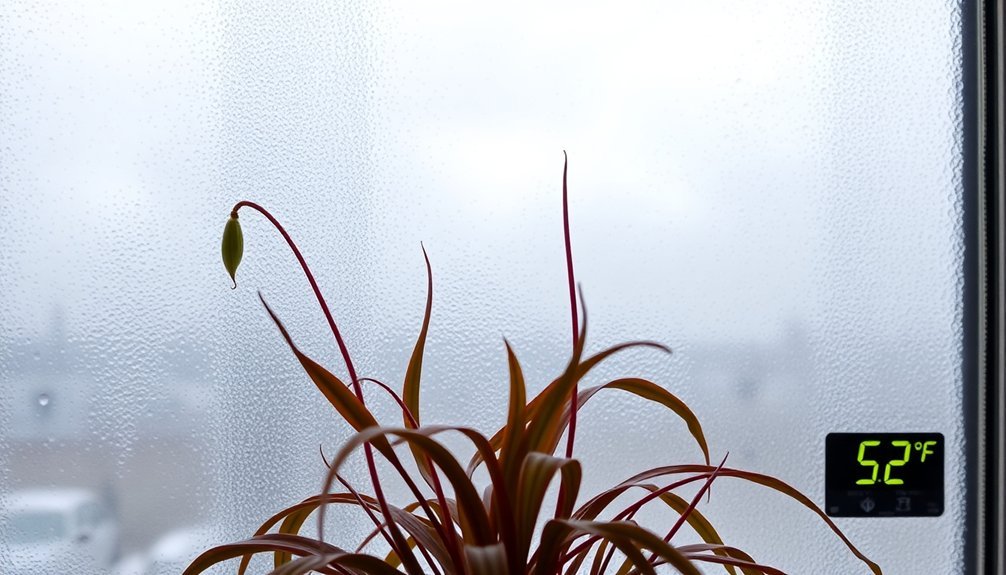
You'll find that sealing window gaps with quality caulking creates a protective barrier against cold drafts while improving your home's energy efficiency and plant health.
Position your plants strategically by using HVAC vent deflectors and maintaining a safe distance from windows and appliances that could create temperature fluctuations.
Consider adding radiator box covers and window insulation materials to establish consistent temperatures that will help your houseplants thrive in their indoor environment.
Seal Those Window Gaps
When cold drafts seep through window gaps, your houseplants can suffer from stress and temperature fluctuations that threaten their health.
You'll need to take action to protect your plants from unwanted air infiltration and maintain a stable growing environment.
Here's what you can do to seal those problematic gaps:
- Apply fresh caulking around your windows to block cold air and maintain consistent indoor humidity levels.
- Install window film or thermal curtains for an extra layer of protection against temperature swings.
- Replace severely drafty windows with energy-efficient models to improve light exposure and temperature control.
- Perform regular inspections of window seals to catch and fix potential draft issues before they harm your plants.
These weatherproofing measures won't just protect your plants—they'll also enhance your home's overall energy efficiency.
Strategic Plant Placement Tips
Since drafty windows pose significant risks to your houseplants, strategic placement becomes essential for their survival and growth.
To protect your plants, start by identifying areas away from drafty windows where temperature fluctuations are minimal. You'll want to focus on spots that aren't directly in the path of HVAC airflow.
Consider creating a plant grouping strategy that forms a protective mini-ecosystem. When you cluster your plants together, you'll naturally increase humidity levels and create a more stable environment.
Install vent deflectors to redirect air away from your sensitive specimens, particularly ferns and ficuses. Remember to monitor temperature changes near windows regularly and adjust plant placement as needed.
This proactive approach will help prevent yellowing leaves, stunted growth, and other stress-related issues that cold drafts can cause.
Insulation Methods That Work
Protecting your houseplants from drafty windows starts with proper insulation methods that create a stable growing environment.
When you implement effective weather-proofing solutions, you'll shield your plants from temperature fluctuations that can harm their growth.
Here's what you can do to insulate your windows:
- Apply caulking around drafty areas to prevent cold air infiltration and improve energy efficiency.
- Install window insulating film, which can cut heat loss by up to 50% while maintaining light transmission.
- Add weather stripping to window frames to seal gaps and maintain consistent temperatures.
- Hang thermal curtains to block cold drafts while still allowing necessary light for plant growth.
For added protection, consider using radiator box covers to shield your plants from both extreme heat and cold drafts, creating an ideal growing space.
Seasonal Changes and Window Draft Patterns
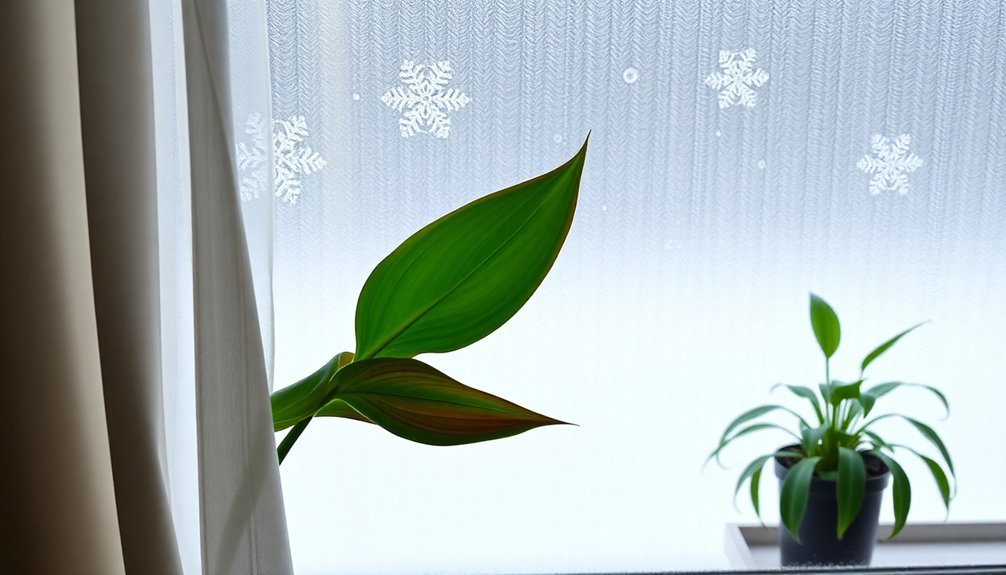
Throughout the year, window draft patterns fluctuate dramatically with seasonal changes, creating unique challenges for indoor plant care.
You'll notice these shifts most prominently during colder months when heating systems cause expansion around window frames, leading to increased gaps and unwanted air infiltration.
Your drafty windows pose a silent threat to plant health, as most houseplants prefer stable temperatures between 60 to 75°F.
When cold air seeps through window gaps, it can stress your plants without showing immediate symptoms. You mightn't notice the effects until your plants display yellowing leaves, reduced growth, or unexpected leaf drop.
To protect your indoor garden, you'll need to monitor draft patterns as seasons change.
Consider repositioning sensitive plants away from problematic windows and applying caulk to seal gaps before winter arrives.
Temperature Monitoring for Optimal Plant Health
When your houseplants display signs of stress, maintaining proper temperature control becomes essential for their survival. Through effective temperature monitoring, you'll keep your plants happy and thriving in their indoor environment.
Most houseplants prefer temperatures between 60-75°F, and staying vigilant about their exposure to cold drafts can prevent leaf damage and growth issues.
To establish an effective monitoring system:
- Place thermometers near your plants to track microclimates
- Check your thermostat settings daily and adjust as needed
- Monitor leaves for signs of cold stress, like curling or dropping
- Install draft blockers or caulk around windows where cold air seeps in
Understanding Plant Cold Sensitivity Levels
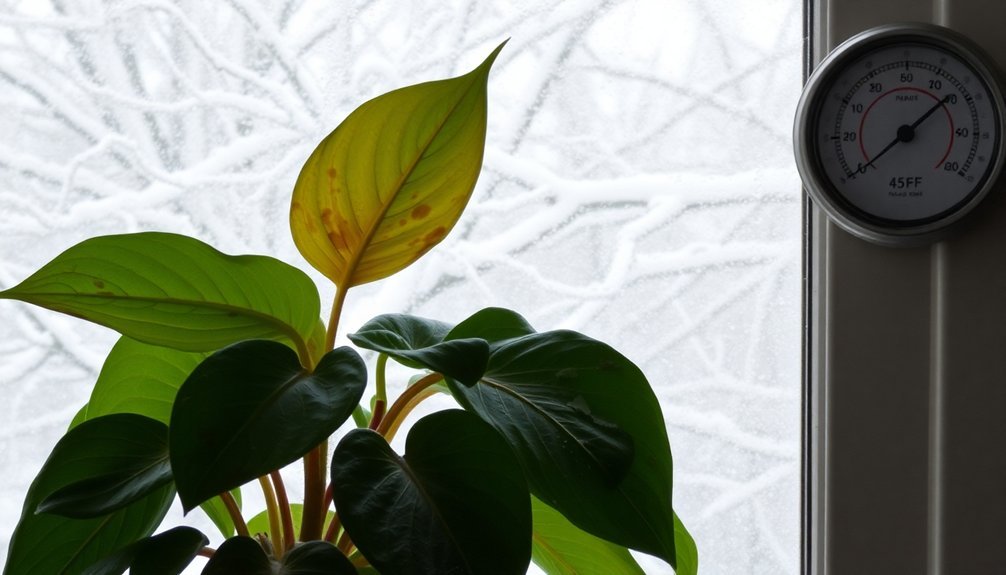
Your houseplants have varying levels of cold tolerance, with tropical varieties like ferns and ficuses being the most sensitive to drafts around windows.
You'll notice signs of cold damage in these plants first, including yellowing leaves, sudden leaf drop, and slowed growth patterns.
If you're growing multiple species, understanding their individual cold sensitivity will help you prioritize which plants need immediate relocation away from drafty spots.
Cold Impact By Species
Different houseplants react to cold drafts in distinct ways, with tropical varieties being especially vulnerable to temperature fluctuations.
The cold impact varies greatly across each plant family, and you'll need to identify your plants' specific needs to protect them effectively.
Here's how common houseplants respond to cold drafts:
- Peace Lilies show moderate resilience, though they'll still struggle with prolonged exposure to temperatures below 60°F.
- Golden Pothos and Snake Plants display immediate stress signs through yellowing leaves when exposed to cold air.
- ZZ Plants and Aglaonema demonstrate better cold tolerance but may experience stunted growth near drafty windows.
- Ferns and Ficuses are among the most sensitive, quickly developing leaf damage when subjected to cold air currents.
To safeguard your plants, you'll want to seal those drafty windows and maintain stable indoor temperatures.
Signs Of Draft Damage
Now that you know how various plants react to cold drafts, spotting the warning signs of draft damage can help you take swift action. You'll notice several telltale indicators when your plants are suffering from cold exposure near drafty windows.
| Warning Sign | What It Means |
|---|---|
| Leaf Curling | Plant's defensive response to cold |
| Yellowing Foliage | Reduced photosynthesis activity |
| Premature Leaf Drop | Severe temperature stress |
| Root Rot | Compromised nutrient absorption |
Watch for these symptoms, especially in your tropical plants and ferns, as they're particularly vulnerable to draft damage. If you notice any of these signs, immediately move your plants to a warmer location away from windows. Remember that prolonged exposure to cold drafts doesn't just affect visible plant parts – it can severely impact root health, leading to long-term growth problems or plant death.
Draft Prevention Tools and Equipment
While protecting houseplants from drafts requires attention to detail, several effective tools and equipment can create a more stable growing environment.
Your houseplants need specific draft prevention tools to thrive during challenging indoor conditions.
Protecting indoor plants requires the right tools to combat drafts and create an environment where they can flourish year-round.
Here's what you'll need to safeguard your plants:
- Caulking materials to seal window gaps and prevent cold air infiltration
- Vent deflectors to redirect harsh HVAC airflow away from sensitive plants
- Radiator box covers to create protective air pockets against extreme heat
- Pebble-filled water trays to increase local humidity levels
Don't forget to regularly inspect household appliances for unexpected drafts and reposition your plants accordingly.
These simple yet effective solutions will help maintain stable temperatures and humidity levels, ensuring your plants remain healthy despite drafty conditions.
Emergency Care for Draft-Damaged Plants
When your houseplants show signs of draft damage, quick action can prevent lasting harm and promote recovery. Move your affected plants immediately to a stable location away from cold air currents to stop further stress.
You'll need to carefully examine them for wilting, yellowing, or browning leaves. As part of your emergency care routine, remove dead leaves and damaged foliage to help your plants redirect their energy toward healing.
Combat the drying effects of drafts by increasing humidity – set up a humidifier nearby or place water-filled trays around your plants.
Don't forget to watch for opportunistic pests that might target your weakened plants. If you spot any infestations, treat them right away to give your plants the best chance at bouncing back from draft damage.
Creating Microenvironments for Sensitive Species
You'll want to group your sensitive houseplants based on their environmental needs, keeping those with similar humidity and temperature requirements together away from drafty windows.
Creating designated humidity zones using pebble trays and strategic plant placement can help maintain moisture levels that counteract the drying effects of winter drafts.
To protect your most vulnerable species, shield them from cold spots by positioning larger, hardier plants as barriers or using decorative screens to block direct exposure to drafty areas.
Group Plants By Needs
Since drafty windows pose unique challenges for houseplants, creating strategic plant groupings can help protect your more delicate specimens.
By understanding your plants' humidity needs and arranging them thoughtfully, you'll create protective microenvironments that support their collective health.
Follow these proven grouping strategies to shield your plants from drafts:
- Place humidity-loving plants like ferns and peace lilies together to boost local moisture through shared transpiration.
- Position hardy plants on the perimeter to shield sensitive species from temperature fluctuations.
- Cluster plants with similar light requirements to optimize their exposure while maintaining warmth.
- Monitor your grouped arrangements regularly and adjust positions based on seasonal changes.
You'll find that grouping plants strategically not only protects them from drafts but also creates self-sustaining environments that enhance their overall well-being.
Create Humidity Zones
Building on the concept of strategic plant groupings, creating dedicated humidity zones takes plant protection to the next level.
You'll boost moisture levels naturally when you cluster plants together, as they'll share humidity through transpiration. This mimics their tropical habitats and shields them from dry drafts.
To create humidity zones, place pebble-filled trays with water beneath your grouped plants. The evaporating water creates a moisture-rich microenvironment that's perfect for sensitive species.
You can enhance this setup by adding a humidifier nearby or positioning your plants close to water features. Don't forget to monitor the humidity with a hygrometer – aim for 40-60% moisture levels.
This approach is especially important for moisture-loving plants like ferns and peace lilies during dry winter months.
Shield From Cold Spots
While drafty windows can pose a significant threat to houseplants, creating protective microenvironments will shield your sensitive species from temperature fluctuations.
You'll need to take strategic steps to protect your plants from cold drafts and minimize temperature shocks that can damage their delicate systems.
Here's how to shield your plants effectively:
- Apply caulking around drafty windows to reduce cold air infiltration and maintain stable temperatures.
- Position your plants away from direct window exposure, creating a buffer zone between them and cold spots.
- Install radiator covers to protect plants from extreme temperature variations near heating sources.
- Group your plants together to establish a protective mini ecosystem that helps maintain consistent humidity and temperature levels.
These protective measures will help your houseplants thrive despite challenging window conditions.
Window Insulation Methods for Plant Safety
When drafty windows threaten your houseplants' health, proper insulation methods become essential for their survival. You'll find several effective solutions to protect your plants from harmful cold drafts.
Start by applying caulk around window frames to seal any gaps, creating a more stable temperature environment. Add weather stripping to further block cold air while maintaining higher humidity levels that tropical houseplants love.
Sealing gaps with caulk and weather stripping helps create the stable, humid environment tropical plants need to flourish near windows.
Consider installing window insulation film as an extra barrier against temperature fluctuations. Thermal curtains offer another layer of protection, helping retain heat and shielding your plants from cold spots.
Don't forget to regularly inspect and maintain your window seals – this simple habit prevents air leaks that could stress your houseplants and cause leaf drop.
These protective measures will help create the consistent environment your plants need to thrive.
Plant Species That Tolerate Draft Exposure
Despite the challenges of drafty windows, several hardy houseplants can flourish in less-than-ideal conditions.
You'll find that these resilient plant varieties don't need special care to thrive near drafty areas, making them perfect for your challenging window spaces.
Consider these draft-tolerant options for your home:
- Snake Plant (Dracaena trifasciata) – Withstands cooler temperatures and occasional drafts while maintaining its striking appearance
- ZZ Plant (Zamioculcas zamiifolia) – Demonstrates exceptional resilience in varying conditions
- Peace Lily (Spathiphyllum) – Adapts well to minor temperature fluctuations while keeping its lush foliage
- Chinese Evergreen (Aglaonema) – Showcases vibrant leaves even in less-than-perfect environments
The Birds Nest Fern is another excellent choice, offering both durability and aesthetic appeal near drafty windows.
Frequently Asked Questions
Are Cold Windows Bad for Plants?
Yes, cold windows can harm your plants by exposing them to chilly drafts and temperature fluctuations. You'll notice yellowing leaves and stunted growth if you don't protect them from window-related cold stress.
Should Indoor Plants Be Near a Window?
Yes, you'll want to place your indoor plants near windows for essential natural light, but don't put them too close to cold, drafty ones. Instead, keep them a few inches away with proper protection.
Can Plants Survive in a Room Without Windows?
You can keep plants alive in windowless rooms using grow lights as substitutes for natural sunlight. While some hardy plants like snake plants and pothos might survive, they'll need artificial light for ideal growth.
What Happens When a Plant Is Kept Near a Window?
When you place your plant near a window, it'll receive natural light for photosynthesis, but if it's drafty, your plant could suffer from temperature stress, yellowing leaves, and reduced growth. Watch for these warning signs.
In Summary
Take control of your plants' environment to prevent the silent damage of drafty windows. You'll see immediate improvement in your plants' health once you address air leaks and create protective barriers. Don't wait until your plants show distress – check for drafts regularly and adjust their locations seasonally. With proper window insulation and strategic placement, you can keep your indoor garden thriving year-round.




Leave a Reply